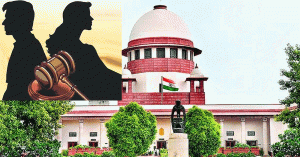We explain the Constitution Bench verdict on the Supreme Court’s powers to grant divorce on the ground of irretrievable breakdown of marriage.
In a significant ruling, the Supreme Court on Monday held that it can dissolve marriages of consenting couples on the ground of irretrievable breakdown of marriage and waive the six-month period they have to wait for under law before getting a divorce.
Although the Constitution Bench laid down factors to consider while determining irretrievable breakdown of a marriage, it clarified that parties cannot directly move the apex court seeking dissolution of marriage.
In this article, we “break down” the five-judge Bench verdict on the Supreme Court’s powers to grant divorce on the ground of irretrievable breakdown of marriage.
What did the Court rule on its power to grant divorce?
The Court held that it can use its discretionary powers under Article 142(1) of the Constitution to grant divorce to an estranged couple by mutual consent without being bound by the legal requirement of the second motion of divorce under the Hindu Marriage Act.
Article 142 empowers the apex court to pass decrees and orders which are necessary for “doing complete justice” in any cause or matter pending before it.
It further held that it can quash and set aside any other proceeding, including criminal cases, filed by warring husbands and wives.
More importantly, the Court held that it can also dissolve a marriage if there is an “irretrievable” breakdown of ties. This power can be wielded in order to do “complete justice” to the parties and where it is established that the marriage has completely failed and there is no chance of reconciliation.
What was the rationale behind the Court’s findings?
Settlements in matrimonial matters invariably end up in multiple legal proceedings, including those of a criminal nature, the Court underlined in its judgment.
This multiplicity of litigation before different fora, including the High Courts, burdens the judiciary in the form of listing, paper work, compliance with formalities, verification and other procedures. The burgeoning litigation and legal procedures also add a financial burden on the parties.
Thus, the Court opined that using its plenary powers under Article 142, it can aid the cause of justice by granting consenting parties a divorce decree.
Can Supreme Court dissolve a marriage without the six-month mandatory cooling-off period before the second motion for divorce is moved?
Yes. The Supreme Court said that it can dissolve a marriage without being bound by the procedural requirement of the second motion.
Section 13B of the Hindu Marriage Act allows divorce to two mutually consenting parties on certain conditions. One of these is that the couple has to wait for six months after filing the first motion of divorce before a district court, so that they have a chance to reconcile their differences.
In its judgment, the Court has said that this provision does not impose any fetters on its powers to grant a decree of divorce on a joint application, when all conditions of the Section are fulfilled and the Court is convinced that it is a fitting case to do so.
In the opinion of the Court, there are cases of exceptional hardship where after years of acrimonious litigation and prolonged suffering, the parties, with a view to having a fresh start, jointly pray to the Court to dissolve the marriage.
In such cases, where continuation of the marital relationship is an impossibility, the Court may waive the need to move the second motion after six months.
What constitutes irretrievable breakdown of marriage?
What makes this judgment significant is that until now, the ground of irretrievable breakdown of marriage is not a ground for divorce under law.
The Supreme Court held that from now on, it can exercise its discretionary powers to grant divorce on this ground, albeit with great care and caution and keeping in mind several factors.
The marriage has to be totally unworkable, emotionally dead and beyond salvation before the Court can decide that dissolution of the marriage is the only way forward.
The factors listed in the judgment are:
1. The period of time the parties had cohabited after marriage;
2. When the parties had last cohabited;
3. The nature of allegations made by the parties against each other and their family members;
4. The orders passed in the legal proceedings from time to time, and their cumulative impact on the personal relationship;
5. Whether, and how many attempts were made to settle the disputes by intervention of the court or through mediation, and when the last attempt was made, etc.
6. The period of separation should be sufficiently long, and anything above six years or more will be a relevant factor.
The judgment highlighted that the duration of separation of the parties had to be sufficiently long, and anything above six years or more would be a relevant factor. However, it added a caveat that all these factors will be evaluated in light of the economic and social status of the parties, including their educational qualifications, existence of children, alimony and related factors.
Can couples move the Supreme Court to get a divorce on the ground of irretrievable breakdown?
No. The Supreme Court has clarified that its judicial orders are not open to correction under Article 32 of the Constitution of India. Therefore, a party cannot file a writ petition under Article 32 of the Constitution of India straightaway to seek divorce.
It further said that grant of divorce by the Court on the ground of irretrievable breakdown of marriage is not a matter of right, but a discretion which is to be exercised with great care and caution. While passing such a decree, the Court has to ensure that ‘complete justice’ is done to both parties.
It echoed a similar sentiment expressed in the 2010 ruling of Poonam v. Sumit Tanwar in which it was held that any such attempt of the parties to circumvent the procedure in place for divorce must be spurned.
“The reason is that the remedy of a person aggrieved by the decision of the competent judicial forum is to approach the superior tribunal/forum for redressal of his/her grievance. The parties should not be permitted to circumvent the procedure by resorting to the writ jurisdiction under Article 32 or 226 of the Constitution of India, as the case may be,” the verdict stated.
Mumbai-based lawyer Mrunalini Deshmukh, who specialises in matrimonial and divorce cases, called it a landmark judgment.
She highlighted that the Supreme Court granting divorce on the ground of irretrievable marriage while invoking Article 142 was something not done earlier.
Deshmukh opines that the ruling can “save lives” and protect couples who do not want to be with each other from agony.
The verdict will also inspire subordinate courts to decide more constructively on matters of divorce, which are otherwise decided purely on the “letter of the law”.
“This has set in motion the spirit of the law. The spirit of the law is to save the institution of marriage. But if the marriage has broken down irretrievably, the court has now said that you can’t flog a dead horse,” she said.
Deshmukh in her experience has witnessed trial courts being bound by a “standard format” and being unable to think outside the box. She feels that trial courts will now have a different outlook, especially after the Supreme Court ruling on the mandatory six-month cooling-off period.
She felt the judgment would also inspire subordinate judiciary to now give some leeway to couples when considering the mandatory six-month cooling off period.
“I think it’s very good that in roads have been made into the marital legislation in our country where we needed this revamping, if I may use the word, and have a more practical and modern view rather than the orthodox view,” added Deshmukh.



